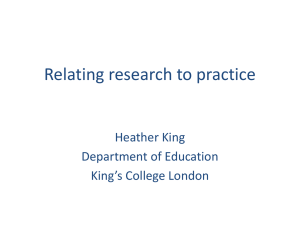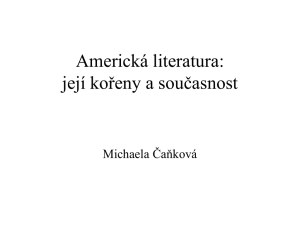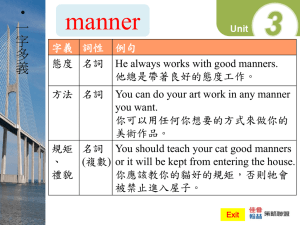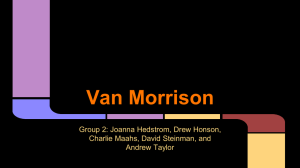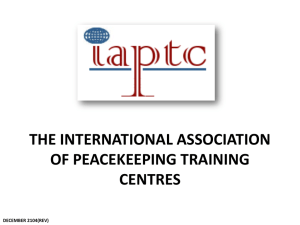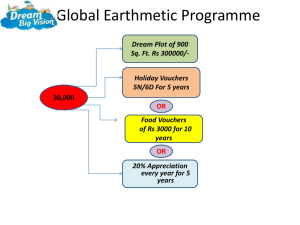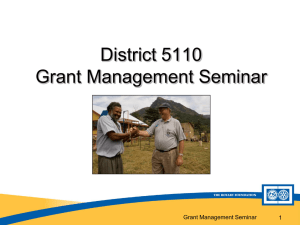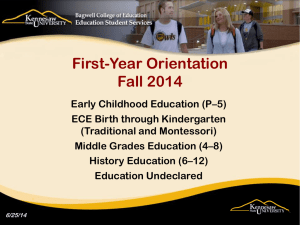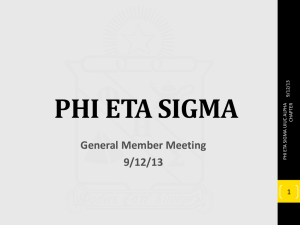Flow Line Theory and Applications - Department of Industrial and
advertisement
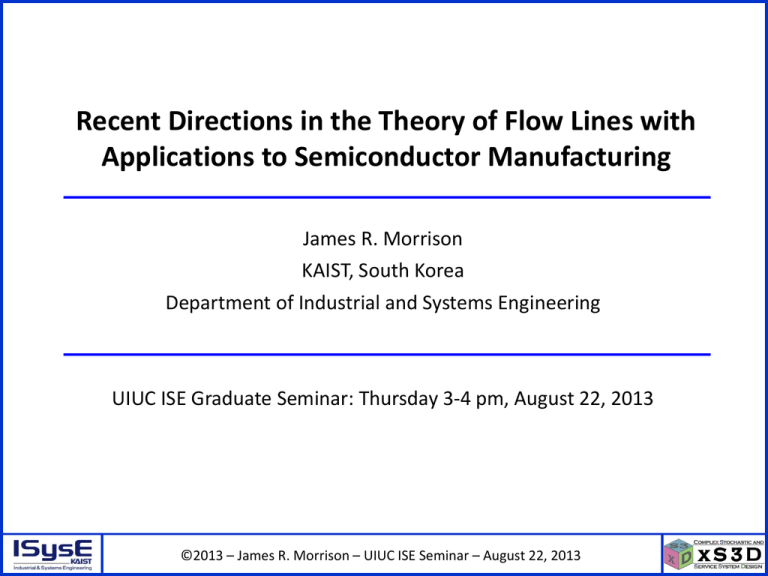
Recent Directions in the Theory of Flow Lines with
Applications to Semiconductor Manufacturing
James R. Morrison
KAIST, South Korea
Department of Industrial and Systems Engineering
UIUC ISE Graduate Seminar: Thursday 3-4 pm, August 22, 2013
©2013 – James R. Morrison – UIUC ISE Seminar – August 22, 2013
Acknowledgements
• Much of the work discussed here was developed with
– PhD student Kyungsu Park
– PhD student Woo-sung Kim
• Several of the slides were prepared by
– PhD student Kyungsu Park
– PhD student Woo-sung Kim
©2013 – James R. Morrison – UIUC ISE Seminar – August 22, 2013 – 2
Flow Line Discussion Overview
• System description: Flow lines
• Literature review: Brief historical perspective on flow lines
• Recent results on regular flow lines with random arrivals
– Exit time recursions
– Exact decomposition
– Buffer occupation probabilities
• Application opportunities in semiconductor manufacturing
• Concluding remarks
©2013 – James R. Morrison – UIUC ISE Seminar – August 22, 2013 – 3
Presentation Overview
• System description: Flow lines
• Literature review: Brief historical perspective on flow lines
• Recent results on regular flow lines with random arrivals
– Exit time recursions
– Exact decomposition
– Buffer occupation probabilities
• Application opportunities in semiconductor manufacturing
• Concluding remarks
©2013 – James R. Morrison – UIUC ISE Seminar – August 22, 2013 – 4
Flow Lines (1)
…
…
• Flow line with a single server for each process and one
customer class
P1
Customers
Arrive
–
–
–
–
–
P2
PM
…
t1
t2
tM
Customers
Exit
Customers require service from all processes P1, P2, …, PM
Service time required from process Pi is ti (it may be random)
Random arrivals and an infinite buffer before the first process
Finite buffers at the intermediate processes
Manufacturing blocking
©2013 – James R. Morrison – UIUC ISE Seminar – August 22, 2013 – 5
Flow Lines (2)
…
…
• Buffers can be considered as a process module with zero
process time
P1
Customers
Arrive
P2
P3
PM
…
t1
t2
t3
tM
©2013 – James R. Morrison – UIUC ISE Seminar – August 22, 2013 – 6
Customers
Exit
Flow Lines (3)
…
…
• There may be multiple servers devoted to each process
P1
R1=2
Customers
Arrive
P2
R2=1
P3
R3=3
PM
RM=2
Customers
Exit
…
t1
t2
t3
tM
©2013 – James R. Morrison – UIUC ISE Seminar – August 22, 2013 – 7
Flow Lines (4)
…
…
• Each customer may have its own class (c)
P1
R1=2
Customers
Arrive
P2
R2=1
P3
R3=3
PM
RM=2
Customers
Exit
…
tc1
tc2
tc3
tcM
©2013 – James R. Morrison – UIUC ISE Seminar – August 22, 2013 – 8
Presentation Overview
• System description: Flow lines
• Literature review: Brief historical perspective on flow lines
• Recent results on regular flow lines with random arrivals
– Exit time recursions
– Exact decomposition
– Buffer occupation probabilities
• Application opportunities in semiconductor manufacturing
• Concluding remarks
©2013 – James R. Morrison – UIUC ISE Seminar – August 22, 2013 – 9
Literature on Flow Lines (1)
• Flow lines serve as prototype models
–
–
–
–
Automobile assembly plants
Printed circuit board manufacturing
Production lines
Manufacturing equipment
[1]
• Well known application
– HP printer manufacturing line redesigned using approximate
decomposition models for flow lines (M. Berman, et al 1998)
– Claim $280 million increase in revenue and printer shipments
• New applications arising in semiconductor manufacturing
[1] http://www.c3systems.co.uk/wp-content/gallery/other-industries/factory-modern-robotic-assembly-line01.jpg
[2] http://www.ventures-africa.com/wp-content/uploads/2012/08/Bottling-plant.jpg
[3] http://cdn5.zyxware.com/files/u1948/images/2011/04/HP%20LASER%20JET(P1007)%20.jpg
©2013 – James R. Morrison – UIUC ISE Seminar – August 22, 2013 – 10
Literature on Flow Lines (2)
• Studied since the 1960’s
• Selected papers below
Process Time
Paper
Class of
customer
Single/
Exact/Bounds
Multi server /Approximation
Setup
Considered
Performance
metric
Etc
Lau (1986)
Single class
Single server
Exact
No setup
Throughput
2 servers
Hildebrand (1956)
Single class
Single server
Exact
No setup
Throughput
3 servers
Mute (1973)
Single class
Single server
Bound
No setup
Throughput
2 or 3 servers
Gershwin ( 1987)
Single class
Single server Approximation
No setup
Throughput
Random failures
B. Avi-Itzhak (1965)
Single class
Single server
Exact
No setup
Exit time
Infinite buffer
before 1st process
Altiok and Kao (1989)
Single class
Single server
Exact
No setup
Exit time
finite buffer before
1st process
J. Morrison (2010)
Single class
Exact
Single server (Decomposition
method)
Setup
Exit time
State-dependent
setup considered
K. Park et. al (2010)
Single Class
Multi servers
Upper Bound
No setup
Exit time
J. Morrison (2011)
Proportional
Single server
multi class
Exact
Setup
Exit time
Upper Bound
Setup
Exit time
Random
Deterministic
K. Park et. al (2012)
Multi class
Multi servers
©2013 – James R. Morrison – UIUC ISE Seminar – August 22, 2013 – 11
Proportional
multi class
Literature on Flow Lines (3)
• Avi-Itzhak (1965)
…
…
– Random customer arrivals and deterministic service times
P1
Customers
Arrive
P2
P3
PM
…
t1
t2
t3
tM
Customers
Exit
• Theorem: Exact recursion for customer completion (exit) times
c M k 1 max a k 1
t m , c M k t B .
m 1
M
– cM(k) is the completion time of customer k from process M
– aK is the arrival time of customer k to the system
– tB is the bottleneck process time
©2013 – James R. Morrison – UIUC ISE Seminar – August 22, 2013 – 12
Literature on Flow Lines (4)
• Altiok and Kao (1989) also studied the exit behavior
– Single server, single class of customer, deterministic service times
– Finite buffer before the first process
• Considerable past and ongoing work to extend the frontiers
– Exact solutions for certain cases (e.g., 2 or 3 processes, Li et al)
– Approximate decomposition methods (e.g., Gershwin et al, Li et al)
• Many unanswered questions about the exact behavior
– No Avi-Itzhak style recursions outside of single server, single class
– From the classic text by Altiok: “[T]here are no known techniques to
obtain measures specific to particular buffers, such as the probability
distribution of the buffer contents.”
©2013 – James R. Morrison – UIUC ISE Seminar – August 22, 2013 – 13
Presentation Overview
• System description: Flow lines
• Literature review: Brief historical perspective on flow lines
• Recent results on regular flow lines with random arrivals
– Exit time recursions
– Exact decomposition
– Buffer occupation probabilities
• Application opportunities in semiconductor manufacturing
• Concluding remarks
©2013 – James R. Morrison – UIUC ISE Seminar – August 22, 2013 – 14
Exit Time Recursions (1)
• Park and Morrison (CASE 2010)
…
…
– Allow multiple servers for each process (one customer class)
P1
R1=2
P3
R3=3
P2
R2=1
Customers
Arrive
PM
RM=2
Customers
Exit
…
t2
t1
tM
t3
• Theorem: Recursive bound for customer completion (exit) times
E ( k ) max a k
M
t
m 1
m
, max E ( k i ) t
i N
(i )
max
– t(i)max is the bottleneck process time for those processes with i servers
– Conjecture that this is an exact result
©2013 – James R. Morrison – UIUC ISE Seminar – August 22, 2013 – 15
Exit Time Recursions (2)
• Park and Morrison (CASE 2012)
…
…
– Allow multiple classes of customers, but prevent overtaking
P1
R1=2
Customers
Arrive
P2
R2=1
P3
R3=3
PM
RM=2
Customers
Exit
…
tc1
tc2
tcM
tc3
• Theorem: Recursive bound for customer completion (exit) times
M
c(w)
a
t
w i 1 i ,
M
M
c(w)
c ( w R ' ( w , k ))
E ( w ) max max E ( w R ' ( w , k )) t i
t
i
ik
i k 1
k 1 ,..., M
M
M
E ( w 1) max t ic ( w ) t ic ( w 1 )
ik
ik
k 1 ,..., M
©2013 – James R. Morrison – UIUC ISE Seminar – August 22, 2013 – 16
,
Exact Decompositions (1)
• Morrison (T-ASE 2010) returns to the model of Avi-Itzhak
…
…
– One server per process, one class of customer
P1
Customers
Arrive
P2
P3
PM
…
t1
t2
t3
tM
Customers
Exit
• System can be decomposed into segments called channels
Channel 1
P1
t1
Channel 2
P2
P3
t2
t3
P4
t4
P5
t5
Channel 3
P6
t6
P7
P8
P9
t7
t8
t9
©2013 – James R. Morrison – UIUC ISE Seminar – August 22, 2013 – 17
P10
t10
P11
t11
Exact Decompositions (2)
• Behavior of a customer in a channel can be characterized
Channel 1
P1
t1
Channel 2
P2
P3
t2
t3
P4
P5
t4
t5
Channel 3
P6
t6
P7
P8
P9
t7
t8
t9
P10
t10
• Theorem: Recursion for customer delay in a channel
Y
3
k min
S
3
max
,Y
3
k 1 t B
max t B , D k
– Y3(k) is the delay experienced by customer k in 3rd channel
– Dk is the kth inter-entry time to the last channel, {.}+ := max{ 0, .}
• Theorem: Channel delays are sufficient information
©2013 – James R. Morrison – UIUC ISE Seminar – August 22, 2013 – 18
P11
t11
Exact Decompositions (3)
• Morrison (T-ASE 2011) allows multiple customer classes
…
…
– Proportional service requirements
P1
Customers
Arrive
P2
P3
PM
…
tc1
tc2
tc3
tcM
Customers
Exit
• System can again be decomposed into channels and their delay
Channel 1
P1
t c1
Channel 2
P2
P3
tc2
tc3
P4
tc4
P5
tc5
Channel 3
P6
t c6
P7
P8
P9
tc7
tc8
tc9
©2013 – James R. Morrison – UIUC ISE Seminar – August 22, 2013 – 19
P10
tc10
P11
t11
Buffer Occupation Probabilities (1)
• Kim and Morrison (TBD): Markovian model for the system
…
…
– Use discrete time system model with geometric arrival process
P1
Customers
Arrive
P2
P3
PM
…
t1
t2
t3
tM
Customers
Exit
• Multi-dimensional Markov Chain
– Each dimension describes the delay in each channel for a customer
Ys3(k)
Ys2(k)
Ys1(k)
©2013 – James R. Morrison – UIUC ISE Seminar – August 22, 2013 – 20
Buffer Occupation Probabilities (2)
• Conjecture: Enables exact computation of equilibrium
probabilities… work in progress
• Kim and Morrison (CASE 2012) include setups
– State-dependent setups as in clustered photolithography tools
– JIT throughput calculations: Exact analytic in some cases
– JIT throughput calculations: Exact algorithmic in others (via MC)
• Can the decomposition be used similarly for multiple
customer classes?
©2013 – James R. Morrison – UIUC ISE Seminar – August 22, 2013 – 21
Presentation Overview
• System description: Flow lines
• Literature review: Brief historical perspective on flow lines
• Recent results on regular flow lines with random arrivals
– Exit time recursions
– Exact decomposition
– Buffer occupation probabilities
• Application opportunities in semiconductor manufacturing
• Concluding remarks
©2013 – James R. Morrison – UIUC ISE Seminar – August 22, 2013 – 22
Applications: Semiconductor Manufacturing Models (1)
• Semiconductor manufacturing
– Global revenue in 2010: US$ 304,000,000,000
– Construction cost for 300 mm fab: US$ 5,000,000,000
– Clustered photolithography tool cost: US$ 20,000,000-50,000,000
Pre-scan track
Wafers
Enter
P1
P1
P2
P2
Buffer
Scanner
P6
P4
P3
P5
P4
P2
Wafer handling robots
P11
Wafers
Exit
P11
P11
P9
P10
P8
P8
P9
P7
P8
Post-scan track
Buffer
Clustered photolithography tool
[1] HIS iSuppli April 2011, [2] Elpida Memory, Inc., available at http://www.eplida.com,
[3] http://www.rocelec.com/manufacturing/wafer_fabrication/
©2013 – James R. Morrison – UIUC ISE Seminar – August 22, 2013 – 23
Applications: Semiconductor Manufacturing Models (2)
• Equipment and fabricator simulations are used to
–
–
–
–
–
Predict value of changes to fabricator capacity
Predict value of changes to fabricator production control policies
Predict capacity of fabricators
Predict cost of future fabricators
…
• Want expressive, accurate and computationally tractable
models
©2013 – James R. Morrison – UIUC ISE Seminar – August 22, 2013 – 24
Applications: Semiconductor Manufacturing Models (3)
• Current models can be excellent: Certain tools and scenarios
• Reduced wafers per lot in next generation 450mm wafer fabs
• Flow line models for clustered photolithography may be more
appropriate (explicitly model the issues causing these errors)
©2013 – James R. Morrison – UIUC ISE Seminar – August 22, 2013 – 25
Presentation Overview
• System description: Flow lines
• Literature review: Brief historical perspective on flow lines
• Recent results on regular flow lines with random arrivals
– Exit time recursions
– Exact decomposition
– Buffer occupation probabilities
• Application opportunities in semiconductor manufacturing
• Concluding remarks
©2013 – James R. Morrison – UIUC ISE Seminar – August 22, 2013 – 26
Concluding Remarks
• Flow lines serve as a prototype manufacturing model
– Studied and applied successfully for many years
– Opportunities: Fundamental theory and new application areas
• Deterministic service times and random arrivals
– Exit recursions and exact decompositions
– Buffer occupation probabilities and JIT throughput
• Application opportunities in semiconductor manufacturing
– Equipment models for clustered photolithography
– Improved fidelity with acceptable computation
• Future directions
– Continue onward
– Industry buy-in for the models and integration with decision models
©2013 – James R. Morrison – UIUC ISE Seminar – August 22, 2013 – 27
References
©2013 – James R. Morrison – UIUC ISE Seminar – August 22, 2013 – 28
